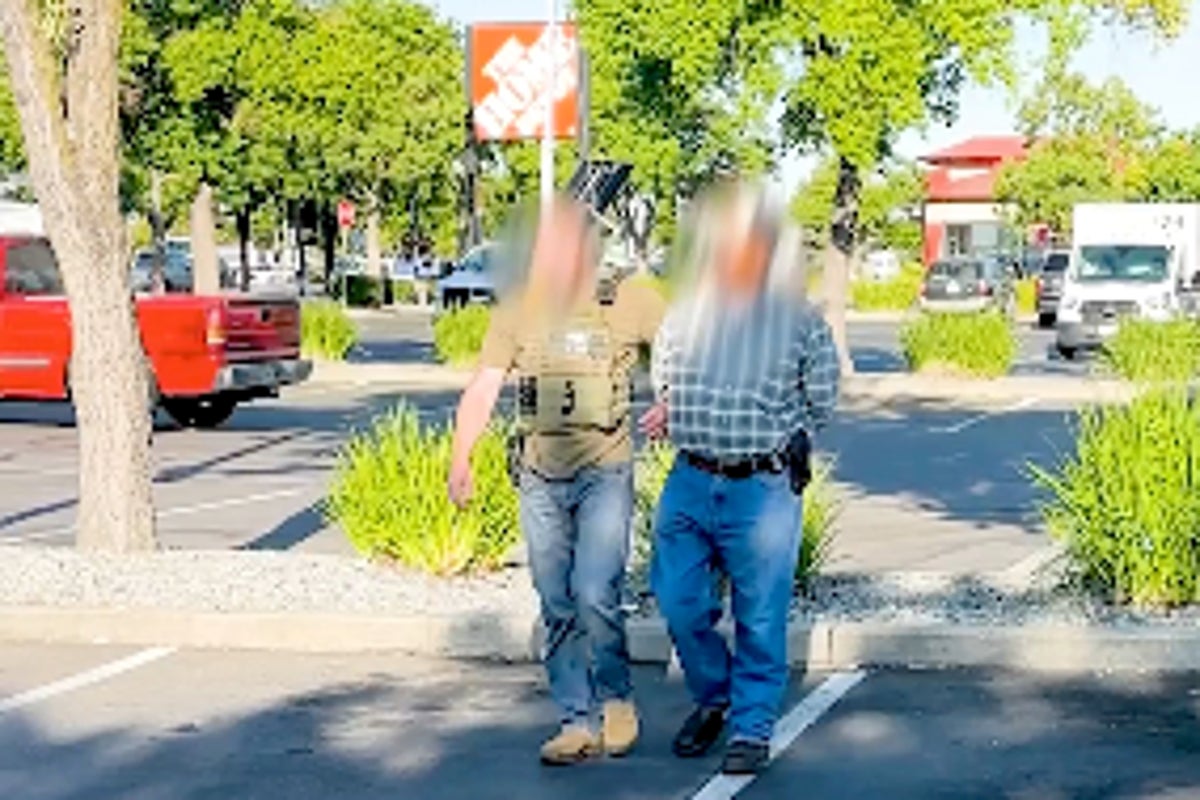- More than 56,000 migrants are in ICE detention
- 47% of ICE detainees are being held on immigration-related offenses
- Trump administration officials have cited sanctuary cities as part of the problem
A man who’s lived in suburban Chicago for 30 years and owns a tree-cutting business has been detained by Immigration and Customs Enforcement for nearly six months, despite his lawyer stating he has no criminal record.
Abel Orozco, 47, was arrested by ICE in late January as he was driving back to his home from picking up tamales for his family. Orosco, who, according to his attorney, the government has conceded has no criminal record, was apprehended by federal officers, who were searching for Orozco’s oldest son, also an immigrant with an order for removal, who shares the same name.
Orozco arrived in the U.S. in the late 1990s under a petition that gave him the right to work and live legally in the United States. He was given an order of removal in 2004 after going to visit his father, who suffered a stroke in Mexico.
His lawyer, Mark Fleming, says his client is part of a collection of undocumented migrants considered “collateral arrests” facing deportation under the Trump administration’s immigration crackdown.
ICE did not have a warrant at the time of the encounter, Fleming said. Orozco is in ICE custody in Kentucky, where he now faces expedited deportation.
When asked for comment surrounding the details of Orozco’s January arrest, an ICE spokesperson told NewsNation that ICE arrested Orozco, “an illegally present resident of Mexico,” on Jan. 26. “He is in ICE custody pending immigration proceedings.”
Orozco’s family has since missed months of mortgage payments despite Orozco’s younger son, Eduardo, doing his best to keep his father’s business afloat, while his wife fights breast cancer, Fleming told NewsNation.
Orozco’s situation has migrant advocates concerned about how ICE is carrying out its business.
“(ICE) has made a conscious choice to destroy this family even though they have other options,” said Fleming, who works with the National Immigrant Justice Center. “What our position to the government has been is, ‘Look, you have the right to seek removal for him, but you have choices as to how you do that.’”
“And they’ve chosen the most aggressive and the one that strips him of the most due process possible.”
Abel Orozco part of class action lawsuit against ICE
Orozco is one of 25 plaintiffs who are part of a class-action lawsuit against ICE, the Department of Homeland Security and federal officials. The suit claims ICE violated a 2022 Castañon Nava settlement that expired in May, which prevents the agency from making arrests without a prior warrant or proof that a person represents a flight risk.
ICE has declined to comment on the suit.
Fleming insists ICE officials have refused to acknowledge they took the wrong person into custody despite the elder Orozco providing officers with his driver’s license when he was asked.
After being pulled out of his vehicle, Orozco was handcuffed for more than an hour, his attorney said.
Before officers drove away with Orozco in custody, Fleming said that ICE officers were on the family’s property without a warrant. Ex-National Guard member convicted of conspiring to smuggle migrants
“What’s so troubling is the permissiveness that they believe they have to do immigration enforcement in a way that you really don’t see other law enforcement do,” Fleming said.
How many non-criminals is ICE holding?
Of the more than 56,000 migrants being detained by ICE, 28% have criminal convictions, while 24% have pending criminal charges, according to the Transactional Records Access Clearinghouse. ICE data shows that 47% of detainees have “other immigration violations.”
A Chicago Tribune analysis of data provided by the research group Deportation Data Project showed that 600 Chicago-area migrants with no known criminal background were booked by ICE in the first 150 days of the Trump administration. That number compares to just 66 in the final 150 days of the Biden administration.
White House border czar Tom Homan has repeatedly warned that “no one is off the table” if they are in the country illegally and says that in some cases, ICE officers searching for the “worst of the worst” may be forced to take non-criminals into custody.
He said that is especially true in sanctuary cities like Chicago, where he says policies are forcing ICE to go into communities to search for migrant criminals.
“There’s going to be more collateral arrests in sanctuary cities because they forced us to go into the community and find the guy we’re looking for,” Homan said in a televised interview earlier this year.
Sam Olson, the enforcement and removal operations director in ICE’s Chicago field office, agreed, telling NBC News that the agency’s job is to enforce immigration laws.
“If somebody is here illegally, whether or not they’re committed crimes, there is a possibility they could be arrested,” Olson said.
Olson did not respond to requests for comment for this story from NewsNation.
Why is ICE holding Abel Orozco?
Despite the order of removal, Fleming said he had not been on ICE’s radar until now, as he continued to operate his business that employs eight people.
But after his arrest by ICE in late January, government officials sought to have his 2004 order to leave the country reinstated, stating that he is among those who broke the law by entering the U.S. illegally.
Orozco’s relative petitioned for him before 2001, which allowed him to remain in the United States and work pending that application. Fleming said that Orozco was living in the United States when that application was submitted, but then everything changed when he went to see his ailing father back in Mexico.
Despite ICE’s stated mission and warnings, Orozco’s family does not agree they are doing their job the right way. Sinaloa cartel quickly losing territories, influence, Mexico says
“(ICE) is arresting people who they’re not supposed to be,” Eduardo Orozco told reporters in March. “They’re stating that they’re arresting thousands and thousands of hardcore criminals. My father is not a criminal.”
“But we’re not just fighting him anymore. We’re fighting for everyone who was taken like this.”
Meanwhile, Orozco’s wife, Yolanda, has pleaded for her husband’s release from federal custody, echoing her son’s sentiments.
“Is it a crime to get up early every day and work hard to support your family? I just don’t know,” she told reporters through an interpreter.
Orozco has an upcoming merits hearing in which he is seeking protection from being forced to return to Mexico. Fleming expects that a ruling may be coming in Orozco’s case by the end of July, after months of him and his family living in limbo.
Fleming believes that as they struggle to comprehend what is happening, Orozco’s loved ones know their journey is similar to those of other migrant families across the United States.
“Mr. Orozco’s story really kind of highlights that this is the collateral consequences,” Fleming told NewsNation, adding, “he is someone who has embraced the United States, embraced how he can contribute to it and really just wants to be here to be here with his family.”
https://www.newsnationnow.com/us-news/immigration/abel-orozco-ice-arrest-collateral








